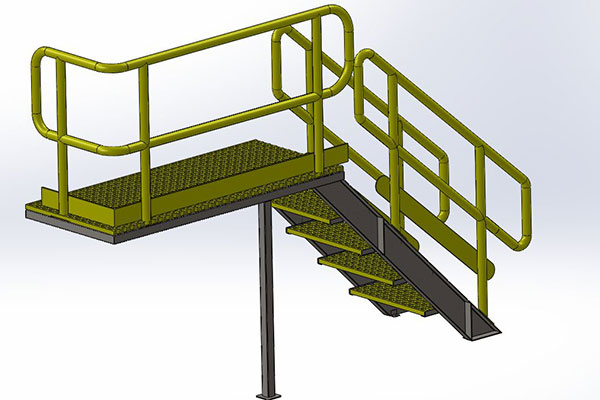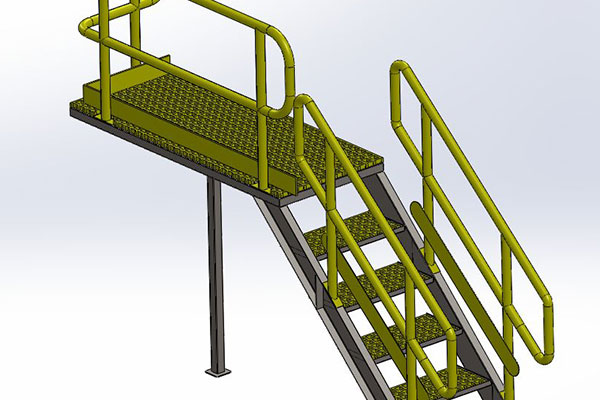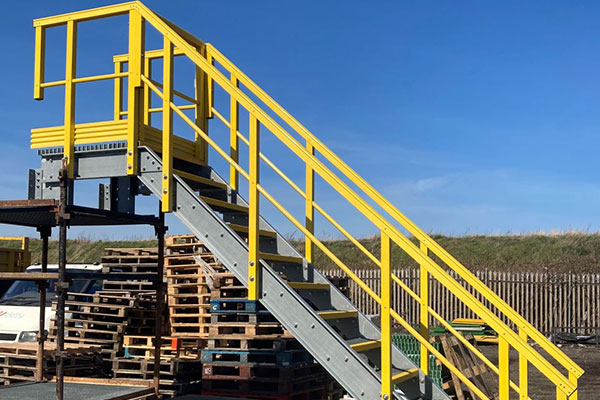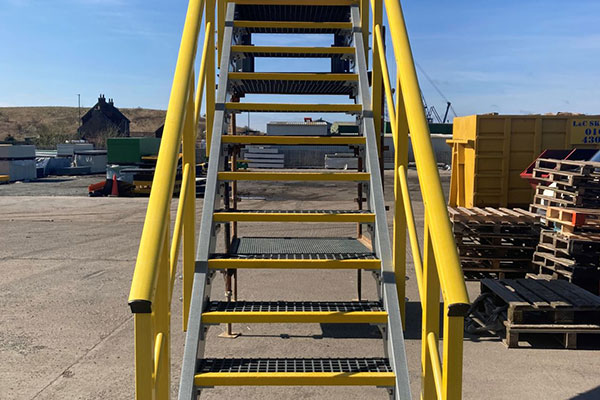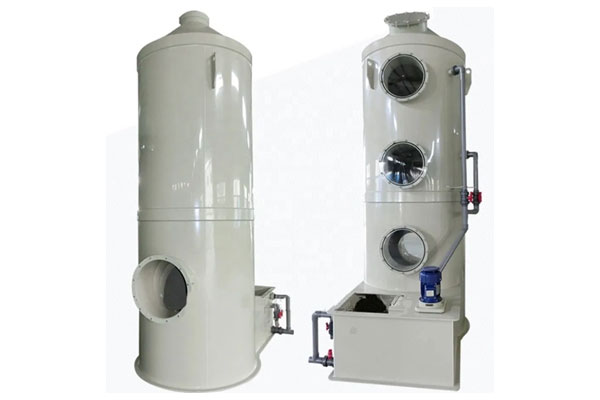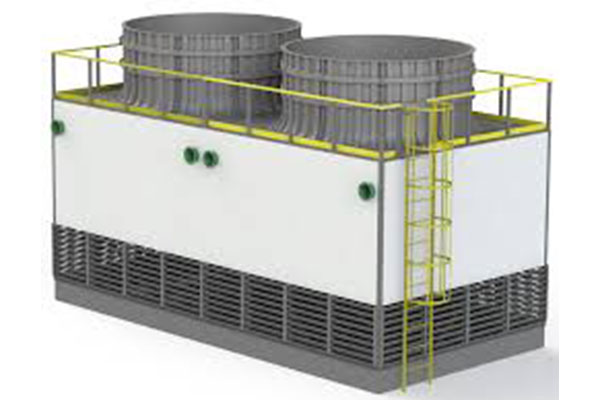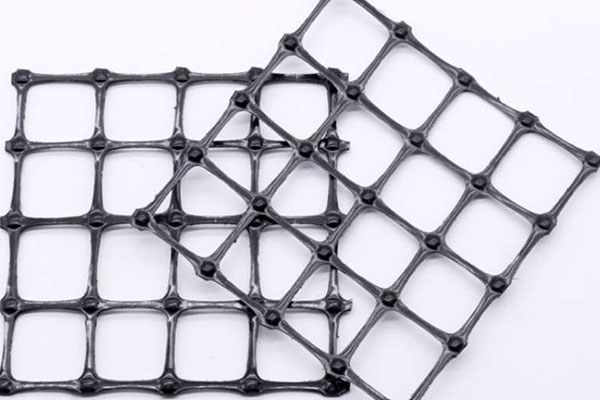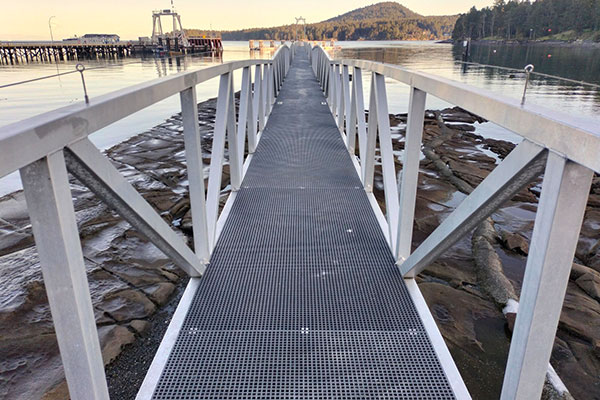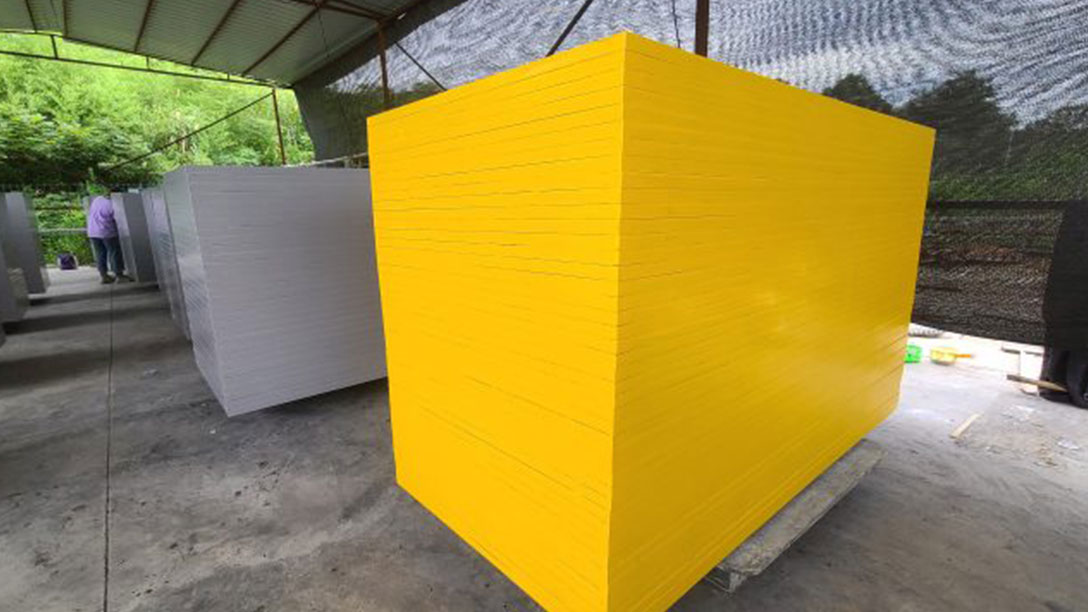ที่ Glass Fiber Reinforced Plastic (GFRP) Ladder Bridge represents an innovative solution for modern infrastructure challenges. Designed using advanced composite materials, the ladder bridge is engineered to provide exceptional strength, durability, and lightweight properties. GFRP technology integrates high-strength glass fibers with a polymer resin matrix, resulting in a structure that withstands corrosive environments, extreme weather conditions, and mechanical stresses far exceeding those encountered by conventional metallic or concrete bridges.
การแนะนำประสิทธิภาพของผลิตภัณฑ์
GFRP ladder bridges are particularly valued in settings where traditional materials may fail or require extensive maintenance. They are ideally suited for pedestrian crossings, maintenance access links, and emergency routes across rugged or restricted areas. With a modular design that lends itself to efficient transportation and straightforward on-site assembly, these ladder bridges offer a sustainable and cost-effective alternative to conventional bridge structures.
The term "ladder bridge" refers to the characteristic design reminiscent of a ladder or step system, whereby a series of steps or rungs are integrated into the bridge deck. This design ensures reliable load distribution, enhanced rigidity, and a lower center of gravity, all of which contribute to improved stability and safety. Because of their composite construction, these bridges remain non-conductive, reducing the risk of stray current interference in critical electrical zones.
2. Key Features and Advantages
The GFRP Ladder Bridge is engineered to meet diverse user requirements and challenging environmental conditions. Key features include:
-
Superior Corrosion Resistance: The composite materials used are inherently resistant to corrosive agents. Unlike steel, which oxidizes over time when exposed to saltwater or industrial chemicals, GFRP components maintain their structural integrity with little need for protective coatings. This is particularly beneficial in coastal, chemical, or industrial applications.
-
Lightweight and High Strength-to-Weight Ratio: The combination of glass fibers and advanced resin systems results in a material that is both lighter than conventional metals and strong enough to support significant loads. The reduced weight simplifies transportation, handling, and installation, especially in remote or difficult-to-access sites.
-
Enhanced Durability and Longevity: GFRP ladder bridges are designed to endure harsh weather conditions, UV exposure, and thermal cycling. With proper design and minimal maintenance, these bridges can offer service lives exceeding 50 years, reducing the need for frequent replacement and lowering long-term lifecycle costs.
-
Low Maintenance Requirements: The non-corrosive nature of GFRP components means that the bridges require minimal routine maintenance. Unlike steel bridges that demand regular painting and anti-corrosion treatments, GFRP bridges maintain their appearance and structural performance with periodic visual inspections.
-
Non-Conductive Properties: The inherent electrical insulation properties of GFRP reduce risks associated with stray currents, making the bridge suitable for locations near high-voltage installations or sensitive equipment. This is particularly relevant in urban and industrial areas where electrical interference can have critical safety implications.
-
Aesthetic Versatility: GFRP surfaces can be finished in various colors and textures. The ability to customize the gel coat allows the bridge to blend in harmoniously with its surroundings or to align with corporate or municipal branding. Anti-slip surfaces and decorative finishes can also be integrated, enhancing both safety and visual appeal.
-
Modular Construction: The ladder bridge is engineered with modular components that allow for quick assembly and on-site installation. Modules are prefabricated under controlled factory conditions, ensuring high quality and precision. Field assembly requires minimal specialized equipment, which expedites project timelines and reduces labor costs.
-
Eco-Friendly Production: The manufacturing process for GFRP components typically results in a lower carbon footprint compared to traditional construction materials like steel and concrete. In addition, the product’s longevity and reduced maintenance demand contribute to overall sustainability.
3. Applications and Suitability
GFRP Ladder Bridges are versatile structures that can be applied to various settings and uses, including:
-
Pedestrian Crossings: Ideal for walkways in parks, nature reserves, campus environments, and urban centers, the ladder bridge provides safe passage with a design that minimizes visual and physical intrusion.
-
Maintenance and Service Access: Many industrial and utility installations require robust, durable access bridges for routine maintenance, emergency services, and inspection. GFRP ladder bridges meet these demands by providing secure, corrosion-resistant pathways to otherwise inaccessible areas.
-
Temporary Infrastructure: For disaster relief or construction site needs, these modular bridges can be deployed rapidly and removed or relocated as necessary. Their lightweight nature and ease of assembly make them a practical choice for temporary load-bearing structures.
-
Remote Location Installations: In geographical regions where conventional construction methods are impractical due to terrain or limited transport facilities, GFRP ladder bridges offer a robust and reliable solution that can be delivered in preassembled sections.
-
Military and Security Applications: The low radar signature and non-conductive nature of GFRP materials render the ladder bridge appropriate for sensitive installations, including military bases or secure facilities, where traditional metal structures may be less desirable.
4. Materials, Manufacturing, and Composition
4.1 Material Composition
The performance of GFRP ladder bridges is a direct result of the materials chosen and the optimized mix used in manufacturing. The primary components include:
-
Glass Fibers:
The reinforcement in GFRP is typically provided by high-strength E-glass or ECR (Electrical/Chemical Resistant) glass fibers. These fibers are chosen for their high tensile strength, excellent stiffness, and superior resistance to environmental degradation. -
Polymer Resin:
The resin matrix binds the glass fibers and transfers loads among them. Common resins include isophthalic polyester, vinyl ester, and epoxy. Each resin offers a distinct profile of chemical resistance, thermal performance, and curing properties. For environments requiring enhanced chemical resistance, vinyl ester resins are often preferred. -
Core Materials (Optional):
In some designs, especially for sandwich panels used in the bridge deck, lightweight core materials such as PVC foam, balsa wood, or honeycomb structures are incorporated. These cores improve stiffness and load distribution while keeping weight to a minimum. -
Gelcoat and Surface Finishes:
An outer gelcoat not only enhances the bridge’s aesthetic appeal but also provides additional environmental protection. Formulations are available with UV inhibitors, anti-slip properties, and a range of colors to suit site-specific requirements.
4.2 Manufacturing Process
The fabrication of a GFRP ladder bridge involves several high-precision manufacturing techniques to ensure quality and performance:
-
การอัดขึ้นรูป:
Continuous fibers are drawn through resin baths and then heated as they pass through a die to create constant cross-section profiles. This technique is ideal for manufacturing bridge components like handrails, beams, and support profiles. -
Resin Transfer Molding (RTM):
This closed molding process involves placing a preform of fibers into a mold and then injecting resin under pressure. The method yields high-fiber volume fractions, resulting in improved mechanical properties and a superior finish. -
Vacuum Assisted Resin Transfer Molding (VARTM):
A more flexible and cost-effective variant of RTM, VARTM uses vacuum pressure to assist in resin flow and infusion. This process is highly suited for creating large, complex parts such as the integrated ladder bridge decking. -
Hand Lay-Up:
For customized or low-volume production, hand lay-up methods allow technicians to place fibers manually into molds, followed by resin application. Though labor-intensive, it facilitates unique or intricate designs with aesthetic detailing. -
Quality Assurance:
Each component undergoes rigorous quality testing. Non-destructive evaluation techniques, such as ultrasound scanning, are applied to detect internal flaws. Tensile, flexural, and impact tests are performed per ASTM or ISO standards to certify that the material properties meet design specifications.
5. Technical Data Sheet (TDS)
The following section outlines the critical technical data and mechanical properties that define the performance of the GFRP ladder bridge. These values are typical; final project specifications may be tailored based on loading conditions, span, and environmental factors.
5.1 Mechanical Properties
| คุณสมบัติ | Typical Range | Test Method/Notes |
|---|---|---|
| ความต้านแรงดึง | 300 – 800 MPa | ASTM D638; depends on fiber volume and resin system |
| Tensile Modulus | 20 – 50 GPa | ASTM D638; influenced by fiber alignment and quality |
| ความแข็งแรงในการดัดงอ | 400 – 1200 MPa | ASTM D790; design dependent on component thickness |
| โมดูลัสการดัดงอ | 25 – 50 GPa | ASTM D790; essential for predicting bending performance |
| ความแข็งแรงในการบีบอัด | 200 – 500 MPa | ASTM D695; measured under multi-axial conditions |
| ความแข็งแรงในการเฉือน | 70 – 150 MPa | ASTM D5379; ensures internal integrity under load |
| Interlaminar Shear | 40 – 80 MPa | ASTM D2344; critical for bonded layers in sandwich panels |
| Impact Strength | 60 – 150 kJ/m² | ISO 179; resistance to sudden load application |
| ความแข็ง (Barcol) | 40 – 60 | ASTM D2583; indicative of surface wear resistance |
5.2 Thermal & Environmental Properties
| คุณสมบัติ | Typical Value/Range | Test Method/Notes |
|---|---|---|
| Glass Transition Temperature (Tg) | 80 – 130 °C | Differential Scanning Calorimetry (DSC) |
| ค่าสัมประสิทธิ์การขยายตัวเนื่องจากความร้อน | 8 – 12 x10⁻⁶ /°C | ASTM E831; ensures minimal deformation with temperature changes |
| Operating Temperature Range | -40 °C to +100 °C (varies with resin choice) | Suitability for harsh environments |
| ต้านทานรังสียูวี | Excellent (with protective gelcoat) | ASTM G154; prolonged exposure tests |
| Moisture Absorption | Less than 0.2% | ASTM D570; important for dimensional stability |
5.3 Fire Performance (Optional Systems)
| คุณสมบัติ | Typical Performance | Test Standard |
|---|---|---|
| Flame Spread Index | Less than 25 (Class I rating) | ASTM E84; depends on resin formulation |
| Smoke Density | Under 450 | ASTM E662; lower values enhance safety |
| Ignition Temperature | Above 350 °C | ASTM D1929; secure against accidental fires |
6. Structural Design Considerations
Designing a GFRP ladder bridge requires a holistic approach that factors in material behavior, load distribution, and environmental conditions. Key areas include:
6.1 Load Analysis and Distribution
The design process incorporates a comprehensive analysis of static and dynamic loads. These include:
-
Dead Loads: Weight of the bridge components themselves, including the decking, rungs, and support structures.
-
Live Loads: Occupancy loads from pedestrian or light vehicular traffic, as defined by national standards (e.g., AASHTO, Eurocode).
-
Environmental Loads: Wind pressure, seismic forces, snow accumulation, and thermal stresses are factored into the design using Finite Element Analysis (FEA).
Engineers perform detailed simulations and load tests to ensure that the bridge maintains a safe factor of safety even under peak load conditions. Using advanced computer modeling, every component is optimized to balance weight with maximum strength.
6.2 Fatigue and Creep Resistance
GFRP materials, while lightweight, are tested for long-term durability under cyclical loading conditions. Fatigue life is a critical parameter, especially for bridges subjected to repetitive pedestrian traffic. Design standards ensure that the GFRP ladder bridge has a high fatigue resistance, minimizing the effects of micro-cracks or material fatigue over decades of use. In addition, long-term creep behavior is assessed to ensure that the bridge retains its structural alignment even when subjected to constant stresses.
6.3 Modularity and Adaptability
One of the standout benefits of GFRP ladder bridges is the modular design approach. Components are fabricated in consistent, repeatable modules that can be assembled in various configurations to suit specific spans and site geometries. This modularity reduces onsite fabrication needs and allows for customized expansions or repairs without the necessity to replace the entire bridge structure.
7. Installation, Assembly, and Quality Assurance
7.1 Prefabrication and Delivery
The construction of the GFRP ladder bridge is performed offsite in a controlled factory environment. This controlled process ensures uniform material properties and minimizes construction variability. Key steps include:
-
Component Fabrication: Each module—including support beams, ladder rungs, and deck panels—is manufactured using high-precision methods such as RTM or VARTM.
-
Quality Control: Each part undergoes non-destructive testing. Dimensional checks, fiber alignment verifications, and resin curing validation ensure that components meet design specifications before shipment.
-
บรรจุภัณฑ์: Components are securely packaged using protective films and shock-absorbent materials to prevent damage during transit. Detailed assembly instructions are included with every shipment.
7.2 On-Site Assembly
The modular design of the GFRP ladder bridge simplifies onsite assembly:
-
Site Preparation: Foundations or abutments are prepared in accordance with structural engineering guidelines. Site surveys and soil analyses inform the foundation design to ensure stability.
-
Module Installation: Using lightweight cranes and alignment equipment, the prefabricated modules are delivered and positioned at the installation site.
-
Fastening Methods: Modules are connected using high-strength, corrosion-resistant fasteners. In many designs, adhesive bonding supplements mechanical connections to create a continuous load path.
-
Final Adjustments and Inspections: Once assembled, the entire structure undergoes field inspections, load testing, and alignment verification. This stage confirms the bridge meets all safety and performance criteria before it is opened to traffic.
7.3 Quality Assurance Programs
Quality assurance is maintained at every stage from production to installation:
-
Factory Certifications: Facilities manufacturing GFRP components are often ISO 9001 certified, ensuring adherence to rigorous quality management practices.
-
Third-Party Testing: Independent inspection agencies perform material testing, structural load assessments, and durability checks.
-
Traceability: Each component is tagged with identification numbers that allow for tracking batch quality and performance history.
8. Environmental Performance and Sustainability
8.1 Sustainable Manufacturing
Compared to conventional bridge materials like steel or reinforced concrete, GFRP offers distinct ecological advantages:
-
Reduced Energy Consumption: The pultrusion and RTM processes used in GFRP production typically require less energy than the production of steel or concrete, leading to a lower carbon footprint.
-
Extended Service Life: With minimal maintenance needs and long-term durability, GFRP ladder bridges reduce resource consumption over their lifecycle.
-
Recyclability: Efforts in recycling thermoset and thermoplastic composites are evolving, allowing end-of-life components to be downcycled or repurposed rather than landfilled.
8.2 Environmental Impact During Installation
The lightweight and prefabricated nature of the bridge minimizes onsite disturbance:
-
Reduced Emissions: Quick assembly means lower onsite fuel consumption, reduced noise levels, and less ecological disruption.
-
Minimal Waste: Components are produced to precise dimensions, reducing material waste. Unused or off-spec components are recycled in accordance with industry best practices.
8.3 End-of-Life Considerations
GFRP ladder bridges are designed with sustainability in mind:
-
อายุยืนยาว: With proven durability under a range of environmental conditions, these bridges offer decades of service without significant intervention.
-
Reusability: Modular components can often be disassembled and refurbished for reuse on new projects, extending their useful life and reducing waste.
9. Certifications, Compliance, and Testing
The GFRP ladder bridge is developed in accordance with rigorous engineering standards and regulatory requirements to ensure safety and reliability:
-
ASTM Standards: Key tests such as ASTM D638 (tensile properties), ASTM D790 (flexural properties), ASTM D695 (compressive strength), and ASTM D2344 (interlaminar shear) are routinely employed.
-
ACI 440 Guidelines: The design and construction of the composite structure follow guidelines established for fiber-reinforced polymers in concrete applications.
-
ISO Standards: Manufacturing and quality control processes align with ISO 9001 and ISO 14001, which cover quality management systems and environmental management, respectively.
-
CE and Local Certification: Where applicable, the bridge meets the requirements for CE marking and other local regulatory approvals, ensuring that the structure is accepted in multiple international markets.
-
Fire and Impact Testing: Optional fire-retardant treatments and impact resistance enhancements are certified via ASTM E84 for flame spread and ASTM D1929 for ignition temperature. Field performance tests confirm that the bridge retains integrity even when subjected to accidental impacts.
10. Maintenance, Inspection, and Lifecycle Management
Despite its high durability, a periodic inspection program is recommended to ensure ongoing safety and performance:
10.1 Routine Maintenance
-
Visual Inspections: Conduct regular inspections (every 1–2 years) to detect any surface imperfections, physical damage, or abnormal wear.
-
Cleaning and Surface Treatment: Over time, debris and dust may accumulate on the surface. Simple cleaning with non-aggressive solvents and water is usually sufficient. Anti-slip surface treatments may be reapplied every 10 to 15 years, depending on usage.
10.2 Scheduled Inspections
-
Load Testing: Before re-opening the bridge to full traffic after major events (such as earthquakes or heavy floods), load tests are performed to verify integrity.
-
Fastener Checks: Regular checks on mechanical fasteners and adhesive bonding points ensure that all connections remain secure.
-
Documentation: Detailed maintenance logs and performance records help predict when components might require servicing or replacement, contributing to proactive lifecycle management.
10.3 Long-Term Lifecycle Benefits
-
Reduced Downtime: With minimal routine maintenance, the bridge remains operational with few interruptions, ensuring continuous service in critical applications.
-
Cost-Effective Operation: Lower lifetime maintenance costs, combined with the extended lifespan, make the GFRP ladder bridge an attractive option for budget-conscious long-term projects.
11. Customization and Aesthetic Options
The versatility of GFRP as a composite material allows for extensive customization to meet specific project demands:
11.1 Tailored Structural Options
-
Modular Configurations: The bridge design can be adapted for varying span lengths, width dimensions, and load requirements. Modules can be optimized for pedestrian-only applications or engineered to support light vehicular loads.
-
Hybrid Structures: In certain cases, GFRP components may be integrated with traditional materials such as steel or concrete supports to enhance the overall load-bearing capacity.
11.2 Finishing and Visual Customization
-
Gelcoat Finishes: A wide range of colors and textures are available to match architectural aesthetics or branding requirements. Anti-slip additives can be integrated into the gelcoat to enhance user safety.
-
Lighting and Markings: Embedded LED lighting or reflective surface treatments can be incorporated along the ladder rungs or side profiles to improve visibility during nighttime or low-light conditions.
-
Decorative Detailing: In applications where appearance is paramount (such as urban installations or cultural landmarks), the composite surface can be customized with decorative patterns or even integrated artistic designs.
12. Warranty, Support, and Ordering Information
12.1 Warranty and After-Sales Support
Manufacturers typically offer a standard warranty of 25 years for structural integrity under normal use. Additional warranty programs or service packages may be negotiated based on the project scope, operational environment, or unique client requirements. Comprehensive technical support is provided, including:
-
Pre-installation consultations
-
Detailed installation manuals and training sessions
-
On-site and remote troubleshooting assistance
-
Periodic post-installation inspections and performance reviews
12.2 Ordering and Project Specifications
To ensure a seamless integration into your infrastructure project, the following details are typically required when requesting a quote or technical consultation:
-
Project Location: Regional or site-specific environmental conditions (e.g., coastal, desert, industrial).
-
Bridge Span and Width: Precise dimensions required for the installation area.
-
Expected Load: Information on whether the bridge will be used for pedestrian traffic, maintenance access, or light vehicular use.
-
Aesthetic Preferences: Desired color schemes, finishes, and any custom decorative requirements.
-
Installation Timeline: Project deadlines and onsite installation constraints.
-
Regulatory Compliance: Local building codes and certification requirements that must be met.
12.3 Order Process
A typical ordering process includes:
-
Initial Consultation: Detailed discussions with engineering specialists to assess site conditions and client requirements.
-
Technical Proposal and Customization: Development of tailored design proposals, including finite element analysis results and material certifications.
-
Contract Negotiation: Finalization of service agreements, delivery schedules, and warranty conditions.
-
Manufacturing and Delivery: Production in certified facilities with consistent quality assurance checks and controlled logistics.
-
Installation and Commissioning: On-site assembly with technical oversight, followed by performance verification tests.
-
Post-Installation Support: Ongoing technical assistance and scheduled maintenance programs ensure long-term operational excellence.
13. Case Studies and Practical Implementations
13.1 Remote Site Pedestrian Bridge
In a remote mountainous region, a GFRP ladder bridge was deployed to connect a series of remote research outposts. The lightweight design enabled rapid transport by helicopter, and modular assembly on-site minimized disruption in a fragile ecosystem. The bridge withstood substantial temperature variations and heavy use during snow and ice conditions, validating the resilience of the GFRP material in severe climates.
13.2 Industrial Maintenance Access Bridge
A chemical processing facility installed a customized GFRP ladder bridge to provide safe access between two critical sections of its plant. The bridge’s resistance to chemical corrosion and its non-conductive properties made it ideal for the environment. Following installation, the bridge was subjected to rigorous load and impact testing, verifying that it met stringent industry standards while offering cost savings in reduced maintenance requirements.
13.3 Temporary Emergency Bridge Installation
In response to natural disaster events, a modular GFRP ladder bridge was rapidly deployed to restore connectivity across an obstructed roadway. Its prefab design allowed for installation within hours, significantly reducing the emergency response time and providing a safe passage for emergency services and relief personnel. The structure was later reconfigured for permanent use after successful performance evaluations.
14. Summary and Conclusion
ที่ Glass Fiber Reinforced Plastic (GFRP) Ladder Bridge delivers a modern, sustainable solution that combines superior mechanical properties with versatile design capabilities. Its lightweight, corrosion-resistant, and durable construction makes it an ideal choice for a diverse range of applications—from remote pedestrian crossings and industrial access bridges to temporary installations in disaster zones.
Key benefits include:
-
อัตราส่วนความแข็งแรงต่อน้ำหนักสูง enabling rapid installation
-
Low maintenance and long service life that lower lifecycle costs
-
Advanced manufacturing processes ensuring excellent quality and precision
-
Customization options that tailor both functional and aesthetic aspects to project needs
Through compliance with international standards and proven performance in field applications, the GFRP ladder bridge is a reliable infrastructure solution offering safety, efficiency, and environmental benefits. Detailed technical data and certification information reassure stakeholders of its performance under a wide range of conditions, making it a compelling option for modern engineering projects.
Prospective users, engineers, and procurement professionals are encouraged to review the enclosed Technical Data Sheet (TDS) for precise specifications, sample test results, and a complete description of manufacturing quality controls. By integrating state-of-the-art composite technology with thoughtful design principles, the GFRP ladder bridge stands at the forefront of next-generation infrastructure, supporting safe and sustainable connectivity across varied environments.
Glass fiber reinforced plastic ladder bridge
ชุด :
สินค้า >แอปพลิเคชัน
A GFRP bridge is a structural system made primarily from Glass Fiber Reinforced Plastic, a composite material that combines glass fibers and a polymer resin matrix. It is designed to offer high strength, lightweight, and exceptional resistance to corrosion, especially in environments where steel or concrete would degrade.
ชื่อแบรนด์ :
ทีเอฟคอมโพสิต
ชื่อผลิตภัณฑ์ :
Glass fiber reinforced plastic ladder bridge
คำถามที่พบบ่อย
ถาม :
What are the advantages of GFRP bridges compared to traditional materials like steel or concrete?
ตอบ :
Corrosion Resistance – No rust, even in marine or chemical environments Lightweight – 50–80% lighter than steel, making transport and installation easier Long Service Life – 50+ years with minimal maintenance High Strength-to-Weight Ratio Non-conductive and Non-magnetic – Ideal for electrical infrastructure Low Maintenance – No painting or recoating needed
ถาม :
What types of GFRP bridges are available?
ตอบ :
Pedestrian Bridges Vehicular Access Bridges (light vehicles) Utility Bridges (pipes, cables) Temporary/Portable Bridges Modular Panel Bridges
ถาม :
Are GFRP bridges strong enough to handle heavy loads?
ตอบ :
Yes, GFRP bridges are designed according to international standards (e.g., ACI, ASTM, Eurocomp) to meet or exceed load-bearing requirements. For vehicular traffic, customized GFRP components are engineered to meet live load criteria like AASHTO H-20 or HS-25.
ถาม :
How are GFRP bridges installed?
ตอบ :
Prefabricated offsite for rapid deployment Delivered in modular sections or full spans Installed using cranes or lightweight machinery No welding – Typically bolted or adhesively bonded connections
ถาม :
How do GFRP bridges perform in harsh environments (e.g., coastal, chemical, desert)?
ตอบ :
GFRP is immune to corrosion, UV stable, and chemically resistant, making it ideal for: Saltwater exposure Acidic or alkaline runoff High-humidity tropical zones Extreme cold or heat
ถาม :
Are GFRP bridges fire-resistant?
ตอบ :
GFRP has limited fire resistance, but fire-retardant resins and intumescent coatings can be applied to meet safety codes. Fire rating depends on the project and regional regulations.
ถาม :
What maintenance is required for a GFRP bridge?
ตอบ :
Visual inspections every 1–2 years Reapplication of anti-slip coatings every 10+ years if required No corrosion treatment, painting, or sealing needed Minimal wear due to inert materials
ถาม :
Are GFRP bridges approved by regulatory authorities?
ตอบ :
Yes. Many systems are designed to comply with: ASTM standards (D3039, D790, D7290) ACI 440 guidelines ISO 9001:2015-certified manufacturing National transportation or infrastructure agency approvals
ถาม :
Can GFRP bridges be customized in terms of appearance?
ตอบ :
Custom colors via gel coats or embedded pigments Textured surfaces (wood grain, anti-slip) Architectural shaping and curves
สินค้าอื่นๆที่เกี่ยวข้อง

